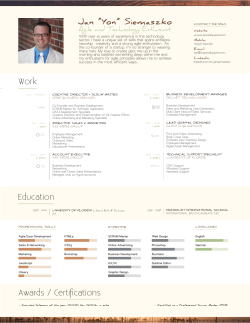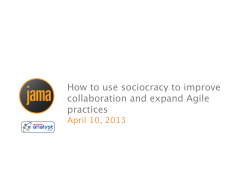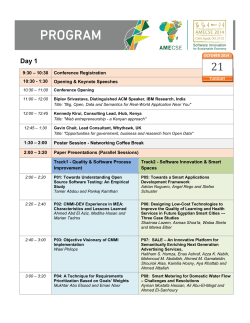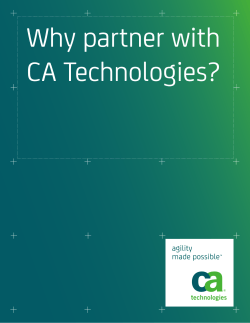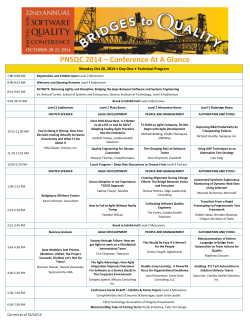
Agile Scrum Foundation Workshop Agile Foundation Examination SAMPLE
IMPROVEMENT BV Liskesweg 2A 6031 SE Nederweert www.improvement-services.nl info@improvement-services.nl tel: 06-55348117 Tools for Optimum Performance Agile Scrum Foundation Workshop Agile Foundation Examination SAMPLE © IMPROVEMENT BV version 1.0 ~ june 2013 Agile Foundation Examination page 1 Preface This examination is an important part of your preparation for the official examination for the Agile Foundation Certificate issued by the Agile Consortium Benelux. The questions are in the style of the Agile Foundation Certificate Examination, which is a 60 question, 1 hour, closed-book examination. Each multiple-choice question comprises a statement or question followed by four options. In each case only one option is correct. The areas specifically targeted are: • • • • • • • • • Agile principles and Scrum practices customer and stakeholder involvement feedback and adaptation handling team dynamics individual leadership style leadership skills prioritisation planning and delivery tailoring © IMPROVEMENT BV version 1.0 ~ june 2013 Agile Foundation Examination page 2 Question 1 The Agile Manifesto states the following values: Your answer: [ [ [ [ ] ] ] ] A B C D Individuals and interactions are more important than contracts. Working software has priority over comprehensive documentation. Responding to change has dominance over contract negotiation. Customer collaboration is more important than following a plan. Question 2 Which of the following is a characteristic of an Agile leader? Your answer: [] A [] B [] C [] D Ability to operate in any mode of leadership, and at the same time observe situations from the perspectives of the other modes. A predictive capability, used for planning out what is going to happen in the project, and to pinpoint pitfalls for less experienced teams. Engage relevant stakeholders to thoroughly review the end-product at the early stages of development, in order to prevent the selforganized team going astray. Recognize the special talents of team members, and give them the tasks that will motivate and inspire them, and satisfy their curiosity. Question 3 An organization has decided to adopt Agile, but management wants to change the terminology to fit with terminology already used. What will likely happen if this is done? Your answer: [] A [] B [] [] C D Without a new vocabulary as a reminder of the change, very little change may actually happen. The organization may not understand what has changed with the introduction of Agile, and the benefits of Agile may be lost. Management may feel less anxious. All answers apply. © IMPROVEMENT BV version 1.0 ~ june 2013 Agile Foundation Examination page 3 Question 4 What might be a valid reason to avoid the Agile methodology? Your answer: [] [] A C [] D [] D Ideas coming at the beginning of the release cycle can be incorporated into our project plan. Ideas later in the release cycle will threaten the on-time delivery of our products. The Agile way of working is explorative and therefore not suited for our fixed-date, fixed-cost projects. We cannot adopt the Agile mindset, since our projects depend on detailed specifications and making upfront project planning. Application users are not always available. The day-to-day partnership between the development team, the sponsor and the end-users does not exist, or is likely to be weak in our projects. Question 4 What option is the least important motive of maintaining consistent iteration length throughout the project? Your answer: [] [] [] A B C [] D It helps to establish a rhythm and a consistent pattern of delivery. It helps the team to objectively measure their own progress It allows multiple teams working on the same product to integrate their work. It provides a consistent means of measuring team velocity. Question 6 According to the Situational Leadership Model, ideal team development moves from immaturity to maturity following four subsequent stages: Your answer: [ [ [ [ ] ] ] ] A B C D Telling, Selling, Participating, Delegating Avoidance, Adaptable, Delegating, Self-Managing Instructing, Adopting, Delegating, Adjourning Vulnerability, Ambiguity, Harmony, Self-Organizing © IMPROVEMENT BV version 1.0 ~ june 2013 Agile Foundation Examination page 4 Question 7 Which option with respect to changing the goal does not correspond to the Agile mindset? Your answer: [] A [] B [] C [] D Frequent task switching is an underestimated, yet major source of waste. Therefore, changing the goal will in general make a team less effective. When the team gets to work knowing with certainty that its commitments will not change, the team's focus on ensuring completion of the agreed-upon tasks will be reinforced. Often changing goals might awaken boundless 'creativity' by overenthousiastic or less disciplined team members to bring in bright new ideas that may slow down team progress. When sticking to the goal is a prominent rule, the Product Owner is disciplined into really thinking through the items that are prioritized on the Product Backlog and offered to the team for implementation. Question 8 Select the answer that is most appropriate for an Agile leader. Your answer: [] A [] B [] [] C D Will utilize the daily stand-up meeting as an opportunity to inspire and motivate the team to move into the most profitable direction. Should involve the team when he or she is allocating tasks to individual team mebers, in order to promote self-empowerment. Has the ability and flexibility to think in a number of different ways. Should respectfully direct the work of the team members, especially if they are inexperienced. Question 9 An iteration is over when: Your answer: [ [ [ [ ] ] ] ] A B C D When all selected user stories meet their definition of done. The iteration review meeting and retrospective are conducted. When all the iteration tasks are completed. When the time-box expires. © IMPROVEMENT BV version 1.0 ~ june 2013 Agile Foundation Examination page 5 Question 10 What is NOT a characteristic of an Agile team? Your answer: [] A [] B [] C [] D Is kept together for multiple projects, in order to preserve productivity and trust. Continuously improve their 'inspect and adapt' attitude, to deliver the highest possible quality. Is formed mostly of generalizing specialists, to promote stability and collaboration within the team. Frequently changes its composition, to foster cross-functionality and learning. Question 11 A burn-down chart shows .... Your answer: [] A [] [] B C [] D The total number of hours spent on tasks by the team during the iteration. The remaining work to complete before the iteration end. The number of hours worked by each team member during the iteration. The rate of spending of the budget for a project. Question 12 Agile leaders are those who ... Your answer: [] A [] B [] C [] D Can persist in the face of ambiguity, uncertainty, and doubt, and who can adapt before their focus becomes obsession. Are able to reduce complexity and remove insecurity for development teams by articulation of a clear, unalterable direction. Are task-oriented because it is concrete, definable, and completion seems finite, which provides stability and focus for the team. Are more demanding than facilitating, in order to promote consensus and to boost the formation of self-disciplined teams. These are questions taken from the full-blown 60-question Agile Foundation examination which is part of the Agile Scrum Foundation Workshop. Participants recieve a preparation guide, the full examination, and afterwards they receive their score, the correct answers + explanation. See for more info: http://www.improvement-services.nl/agile-scrum-foundation-training.html © IMPROVEMENT BV version 1.0 ~ june 2013 Agile Foundation Examination page 6
© Copyright 2025
